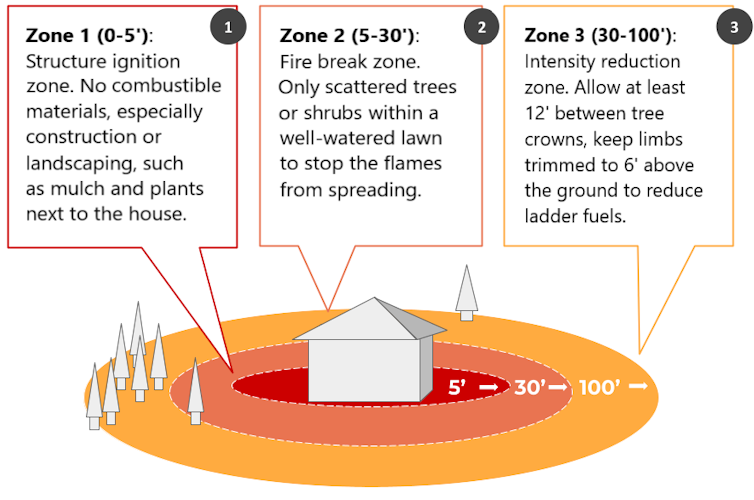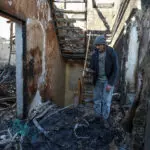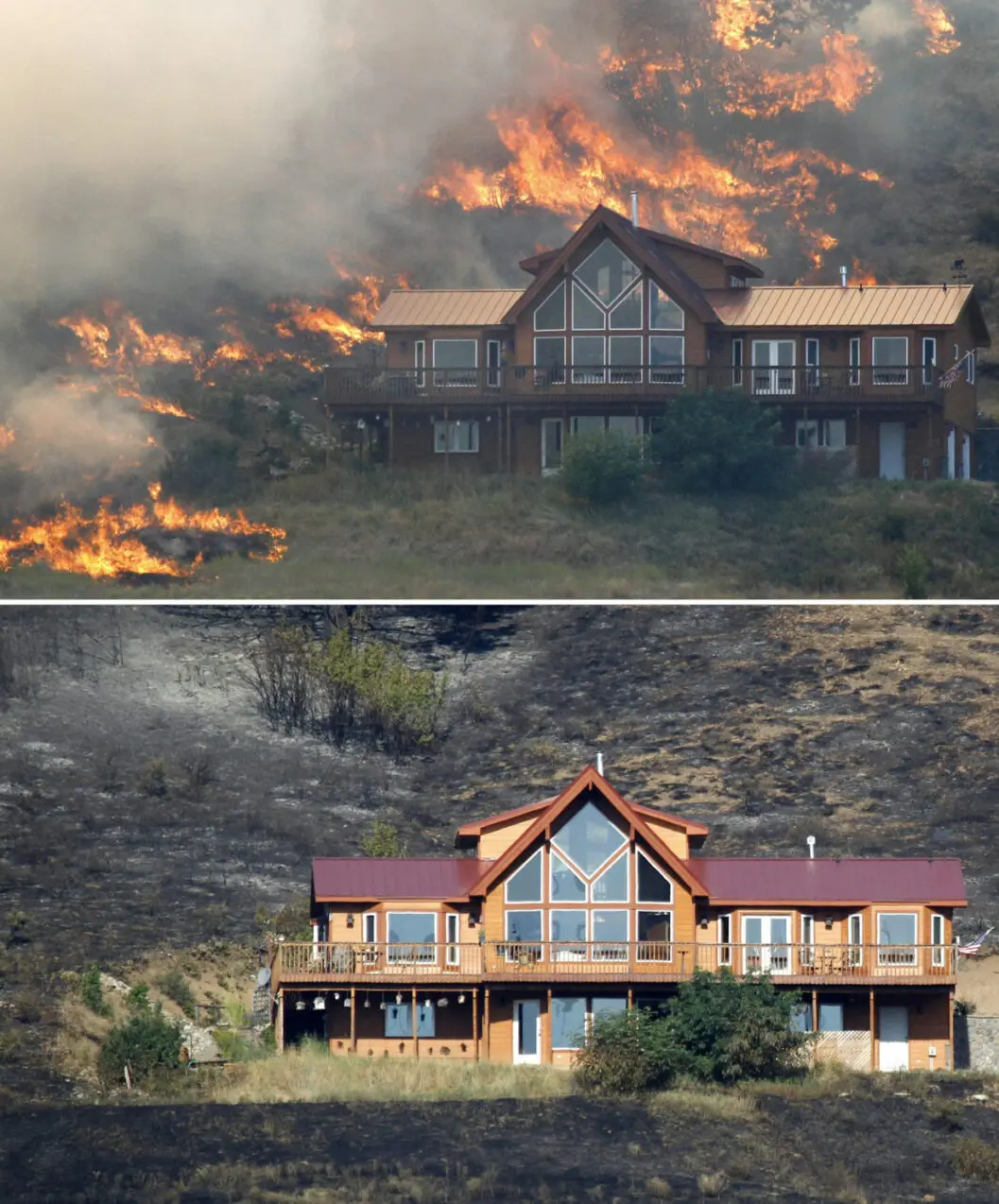Small improvements make big differences
A structure’s flammability depends on both the materials that were used to build it and the design of the building. In general, the vulnerability of a house is determined by its weakest point.
The roof, windows, siding and vents are all vulnerable points to pay attention to.
Roof: The roof provides a landing pad where airborne embers can accumulate like snowflakes. Roofs with lots of valleys can collect pine needles and leaves, which can be ignited by flying embers. This is why it’s important for the roof itself to be made of Class A non-flammable material like clay tiles or asphalt shingles, and why roof maintenance, including cleaning gutters, is important. Embers can easily find their way under peeling shingles, through gaps of clay tiles, or into gutters where pine needles and leaves can accumulate.
Windows: If windows are exposed to heat, they can shatter and allow fire inside the home, where curtains can easily ignite. Even double-paned windows can be shattered by the heat of a burning shed 30 feet away, unless the window glass is tempered, making it stronger. Fire-resistant shutters made of metal, if closed before a fire arrives, can offer additional protection.
Siding: Materials like stucco are non-flammable, while cedar shake siding will burn. Your exterior siding should be non-flammable, but the siding is only as strong as its weakest point. If there are holes in the siding, plug them with caulk to prevent embers from reaching the wooden frame in your walls. Ideally, there will be a 6- to 12-inch concrete foundation between the ground and the bottom of your siding material.
Vents: Reducing risk from vents is easy and affordable and can drastically reduce the flammability of your home. Make sure that one-eighth inch or finer metal mesh is installed over all vents to keep embers out of your attic and your home’s interior.
Controlling your home ignition zone
A home’s vulnerability also depends on the area around it, referred to as the home ignition zone.
The risk in your home ignition zone depends on things such as the slope of your land and the ecosystem surrounding your home. Here are a few guidelines the National Fire Protection Association recommends, both to reduce the chance of flames reaching your home and make it easier for firefighters to defend it.
Zone 1 – Within 5 feet
From the home’s exterior to 5 feet away, you want to prevent flames from coming in contact with windows, siding, vents and eaves. The gold standard is to have only non-flammable material in Zone 1.
The most common risks are having flammable mulch, plants, firewood, lawn furniture, decks and fences. These items have been a primary reason homes burned in many wildfires, including the 2018 Camp Fire that destroyed much of Paradise, California, and the 2012 Waldo Canyon Fire near Colorado Springs, Colorado.

Replacing mulch with gravel or pavers and having only short, sparse plants that don’t touch the house can help reduce the risk.
Wooden decks and fences can burn even if they are well-maintained. Replacing them with non-flammable materials or installing a thin sheet of metal on the house where the siding touches a wooden deck or fence can help protect the home. Mesh screens can prevent the accumulation of debris and embers under the deck.
Zone 2 – 5 to 30 feet away
In the next ring, between 5 and 30 feet from the home, the lawn should be green and short. This is Zone 2.
Be sure to rake up pine needles and leaves and take care to prune the lowest tree branches at least 6 feet high.
There should be about 18 feet of space between trees on a flat slope, and the spacing should increase with slope because steeper terrain drives faster, more intense fires. Walks, pathways, patios, decks and firewood can be kept in this zone.
Zone 3 – 30 to 100 feet away
Beyond Zone 2 and out to about 100 feet from the home is Zone 3. In this area, be sure to give sheds and propane tanks their own defensible space, just like around the house, and prune all low branches to 6 feet.
You can contact your local emergency management office or community wildfire nonprofit to learn more about grant funding that can offset the costs of pruning and removing trees on a forested property.
Beyond 100 feet may extend past your property boundary, but the adjacent house can still be fuel for a wildfire. That’s why it’s smart to plan with your neighbors as you’re reinforcing your own home. Once one house catches fire, house-to-house fire spread is facilitated by closer distances between buildings.
Be prepared
While most U.S. government spending aims to mitigate wildfire hazard on national forests, it is up to residents and communities themselves to reduce their vulnerability to a wildfire disaster.
Following the guidelines required by your community or state and those outlined above can help. Communities can also take steps to reduce fire risk and make fires easier to control by developing a community wildfire protection plan, exploring their wildfire risk, and adopting wildfire-specific building codes.
As the nation rolls into fire season, make sure your property is prepared. And when the call to evacuate comes, know where to go and get the heck out.

Bryce Young receives funding from University of Montana. He also works for Pyrologix and Vibrant Planet.
Christopher Moran also works for Pyrologix, a wildfire threat assessment research firm, and Vibrant Planet.
Source: The Conversation

 Why AP called Arizona for Trump
Why AP called Arizona for Trump
 Trump wins Arizona, sweeping all seven battleground states, Edison Research says
Trump wins Arizona, sweeping all seven battleground states, Edison Research says
 China, Indonesia enhance ties with key deals on lithium, green energy, tourism
China, Indonesia enhance ties with key deals on lithium, green energy, tourism
 King Charles III and Kate will attend remembrance events as both royals slowly return to duty
King Charles III and Kate will attend remembrance events as both royals slowly return to duty
 Taliban administration officials to attend UN climate conference in Azerbaijan
Taliban administration officials to attend UN climate conference in Azerbaijan
 Trump has vowed to kill US offshore wind projects. Will he succeed?
Trump has vowed to kill US offshore wind projects. Will he succeed?
 US to speed up interceptor missiles delivery to Ukraine, WSJ reports
US to speed up interceptor missiles delivery to Ukraine, WSJ reports
 Jalen Milroe runs for career-high 185 yards and 4 TDs as No. 11 Alabama thrashes No. 14 LSU 42-13
Jalen Milroe runs for career-high 185 yards and 4 TDs as No. 11 Alabama thrashes No. 14 LSU 42-13
 Justin Allgaier wins 1st NASCAR Xfinity title, capping comeback by passing Hill and Custer late
Justin Allgaier wins 1st NASCAR Xfinity title, capping comeback by passing Hill and Custer late
 Evan Mobley scores 23 points and Cavaliers rally past Nets 105-100 to remain perfect at 11-0
Evan Mobley scores 23 points and Cavaliers rally past Nets 105-100 to remain perfect at 11-0
 This house near Cle Elum, Wash., survived a 2012 wildfire because of the defensible space around the structure, including a lack of trees and brush close the house, according to state officials.
This house near Cle Elum, Wash., survived a 2012 wildfire because of the defensible space around the structure, including a lack of trees and brush close the house, according to state officials.
